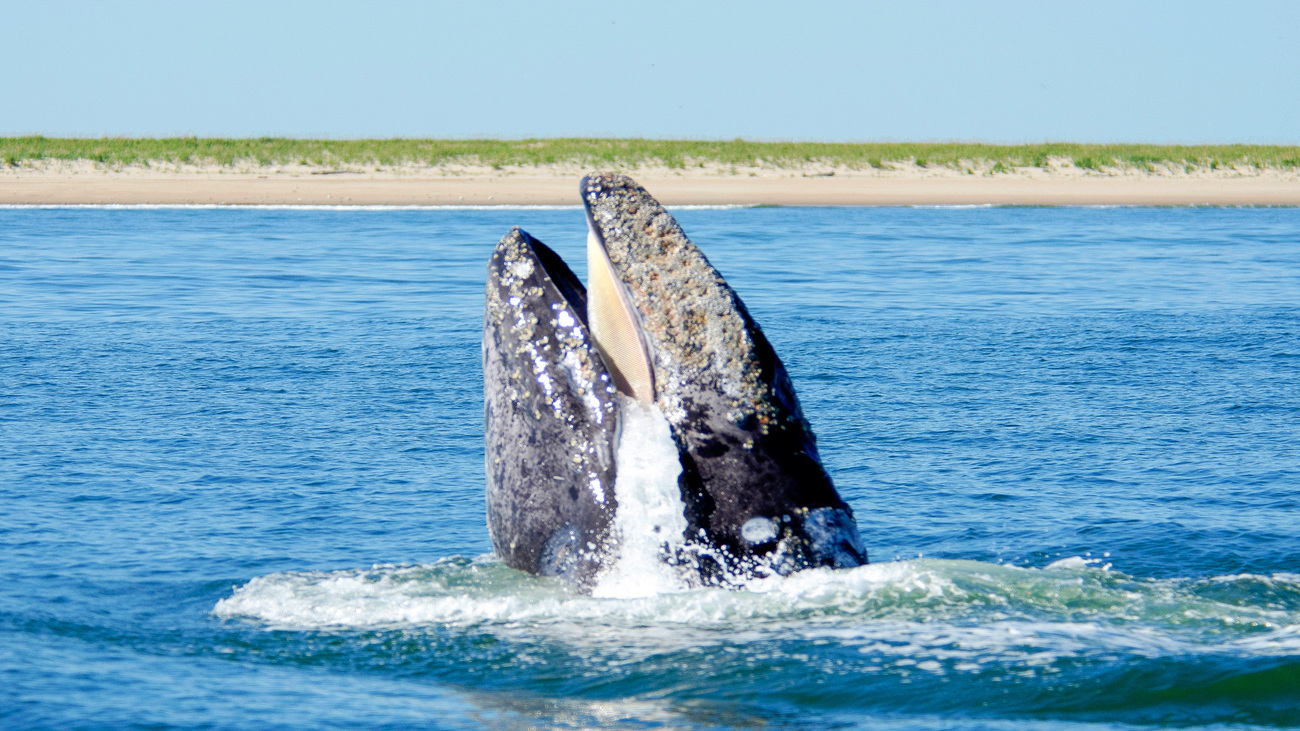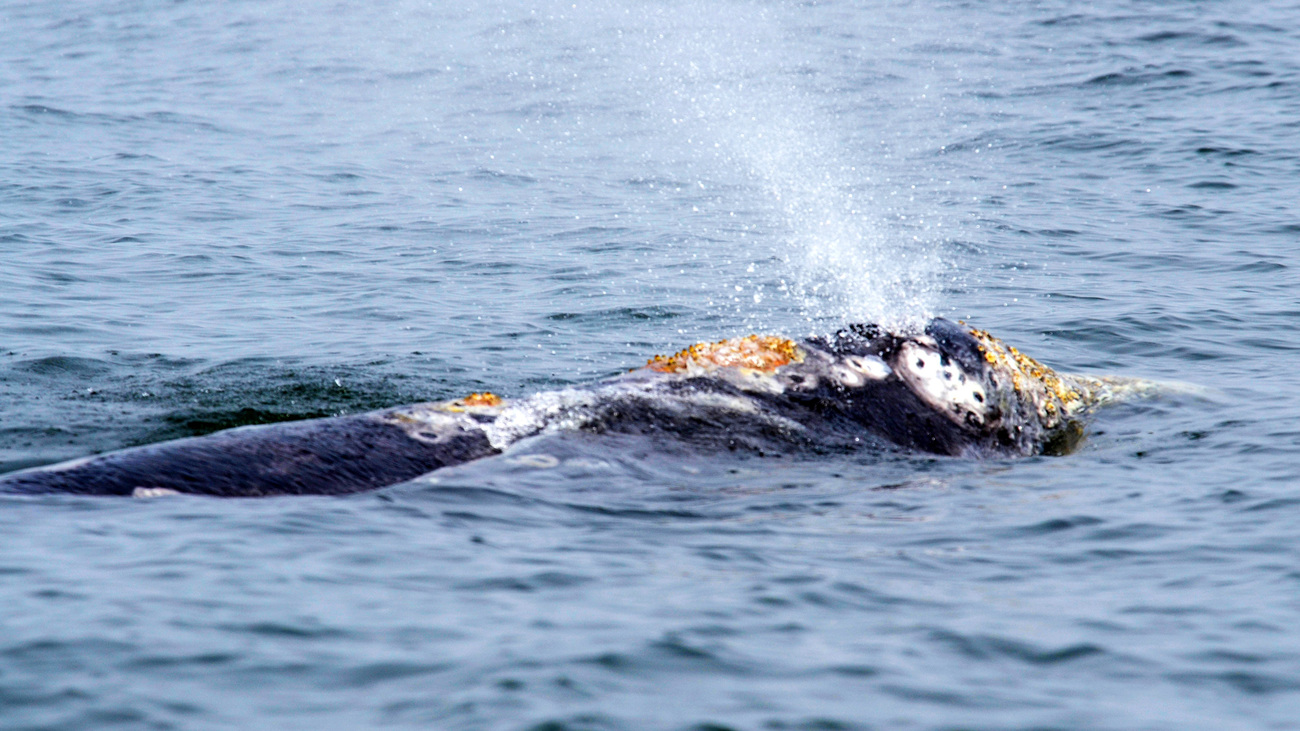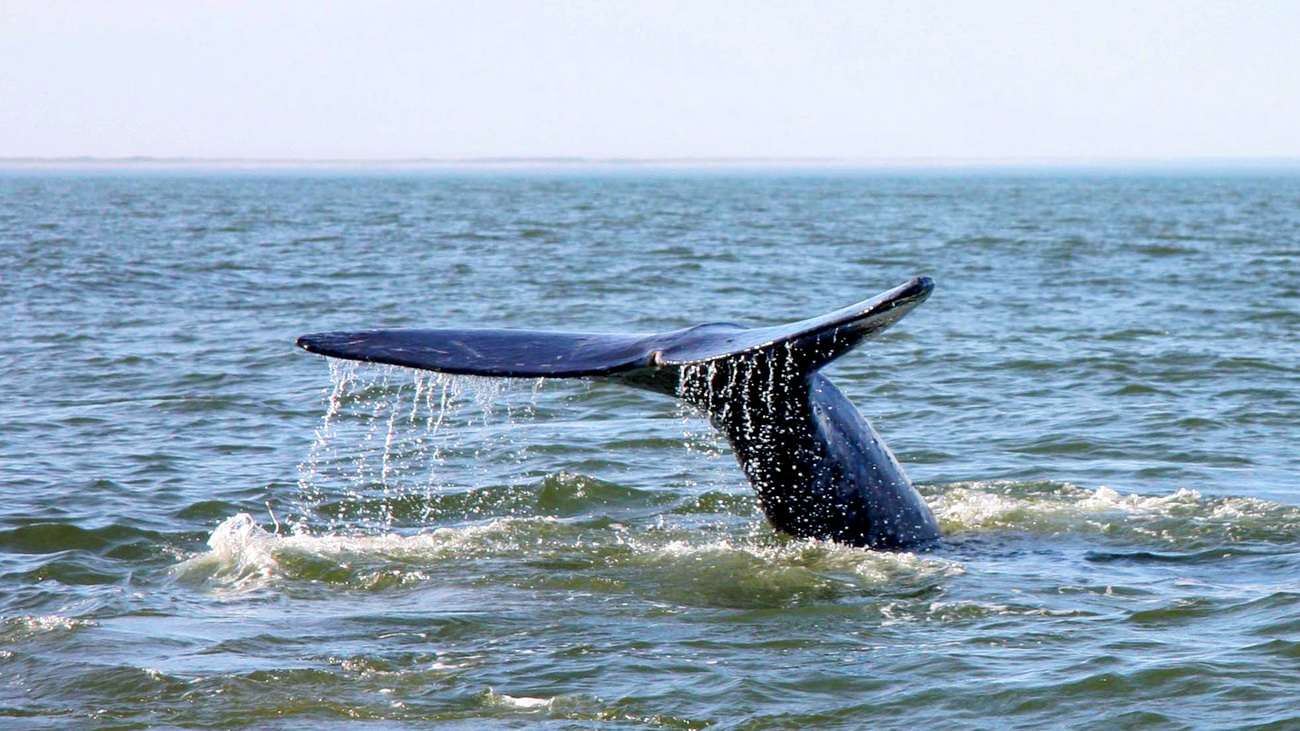Gray whales
Gray whales are one of over 90 species of whales. Along with bowhead whales and blue whales, gray whales belong to the baleen whale category. Baleen whales are called so because they have mouths filled with baleen—fibrous fringed plates made of keratin—rather than teeth.
Gray whales forage for their prey by scooping huge mouthfuls of mud from the seafloor and filtering out tiny crustaceans, tubeworms, and other marine organisms with their bristly, brush-like baleen. Due to this unique style of bottom-feeding, gray whales play a vital role in their ecosystems, creating nutrient-packed mud plumes that in turn enrich life on the seafloor and bring crustaceans to the surface for seabirds to eat.
Despite living in the water, gray whales breathe air and nurse their young—they’re mammals. As their name suggests, these whales are grey. Gray whales have a small head in comparison to other baleen whales, no dorsal fin, and a thick layer of blubber to protect them from icy ocean waters. Both male and female gray whales can weigh up to 41,000 kilograms (90,000 pounds). Similarly to other baleen whales, though, females tend to be slightly bigger than male whales, with a maximum length of around 15 metres (49 feet).
Like the North Atlantic right whale, gray whales once lived in the North Atlantic Ocean, with sub-fossil remains confirming their presence off the coasts of New England, Iceland, and the UK. However, gray whales disappeared from the region in the 18th century, when larger-scale commercial whaling began.
Now, gray whales can be found living in two distinct populations. A small western gray whale subpopulation lives in seas off the western North Pacific Ocean, while a much bigger population of gray whales lives in the eastern North Pacific Ocean.
In winter, gray whales migrate to warmer waters to mate and reproduce. Since the gray whale’s gestation period is approximately 13 months, calving occurs around every two years. Female gray whales lactate for seven months and—with male gray whales taking little interest in their young—are the sole caregivers of their calves.
Gray whales are often observed travelling alone or in small, unstable groups and will generally only congregate in larger groups for feeding and breeding. As with other types of baleen whales, it’s rare for gray whales to forge long-term bonds with each other.
What is a gray whale’s scientific name?
The scientific name for the gray whale is Eschrichtius robustus. The name of the genus Eschrichtius honours the 19th-century Danish zoologist Daniel Eschricht, who was the authority on whales at the time. The species name robustus comes from the Latin word for strong.
Are gray whales endangered?
The International Union of the Conservation of Nature (IUCN) last assessed the status of gray whales in 2017 and classified them as a species of least concern.
The gray whale was hunted almost to extinction by 1925, but its numbers have increased rapidly since the 1940s after the species was placed under international protection. Estimates even suggest that there are now more gray whales living in the Pacific than in 1847 when commercial whaling began in the region.
It’s a different story for the western gray whale, which lives in the northwest Pacific Ocean. This subpopulation is unfortunately classified as endangered.
Where do gray whales live?
Since they are primarily bottom-feeders, gray whales are restricted to the shallow waters found closer to the shore. Sticking to a largely coastal habitat allows them to access the seabed more easily for regular feeding.
Geographically speaking, gray whales can be found living in two distinct populations within the Pacific Ocean. Most of the world’s gray whales live in the eastern North Pacific. However, as migratory animals, gray whales don’t stay in the same place for very long. During the summer, they live in the icy waters of the Bering and Chukchi Seas between the coasts of eastern Russia and Alaska. As the ice begins to advance in late autumn, gray whales embark on one of the longest-known migrations of any mammal. They travel more than 10,000 kilometres (6,000 miles) south to their habitat off the coast of Baja California in Mexico for mating and calving.
Migrating gray whales stay close to shore in waters less than 180 metres (600 feet) deep. Since gray whales swim at a slow speed of just eight kilometres (five miles) per hour, the southward trip takes them two to three months to complete. Gray whales remain in these warmer waters for two to three months to allow their calves to build up a thick layer of blubber. During the spring, gray whales make the journey back northward, taking another two to three months to reach the icy Arctic waters where they spend their summers.
A much smaller western gray whale subpopulation lives around the coasts in the northwestern Pacific. These gray whales spend their summer in the Sea of Okhotsk, largely bordered by Russia, and migrate down to the coast of South Korea in winter.
Threats
Some of the main threats gray whales face today include commercial whaling; human activities including fishing, vessel strikes, entanglement, and underwater noise pollution; and habitat degradation. Learn more about the threats they face below.

Commercial whaling
Iceland, Norway, and Japan continue to practise commercial whaling. Over 1,000 whales per year are killed in this way, with this number likely to include some gray whales. Endangered western gray whales may cross paths with whalers operating in the territorial waters of Japan while migrating from the Sea of Okhotsk down to the coast of South Korea.
Human activity
Aside from whaling, other human activities in the ocean can have adverse effects on gray whales. Many shipping lanes and fishing areas overlap with areas where gray whales feed, give birth, nurse their young, and migrate between their summer and winter habitats. This increases the chances of their exposure to pollution, collisions with vessels, and entanglement in fishing gear.
The underwater noise created by vessels is also a concern since it can make it difficult for gray whales to communicate with each other.
Habitat degradation
Habitat modification and degradation caused by offshore oil and gas developments may interfere with gray whale behaviour and their ability to source sufficient food. Pipelines, platforms, and other forms of ocean-based infrastructure have the potential to disrupt gray whale feeding grounds and block their usual routes of migration.
Climate change and its effects, such as shifting ice coverage and changing water temperatures, also pose a threat to gray whales and their ongoing survival—especially since they rely on environmental cues for navigation and migration between their feeding and breeding grounds.
FAQs
What do gray whales eat?
Gray whales are the only bottom-feeding baleen whales. Baleen whales get their name from their fringed plates of keratin called baleen, which hang down on either side of their upper jaw. Gray whales have the coarsest baleen of all whales—they have about seven to eight per centimetre (20 per inch).
As bottom-feeders, gray whales source their prey by diving down to the seafloor, turning on their side, and opening their giant mouths to scoop up whatever lies in their path. In addition to mud, sand, and other elements, this unique feeding method allows gray whales to capture tiny organisms, which they can then consume after filtering out any non-edible materials with their baleen.
The gray whale diet mainly consists of amphipod crustaceans as well as other tube-dwelling invertebrates such as molluscs and tube worms. They are also known to consume a variety of other sealife opportunistically, including red crabs, baitfish, crab larvae, herring eggs, cephalopods, and megalops.
Gray whales feed almost exclusively during the summer. While they’re in their northern feeding grounds in the summer, they can eat around 1,300 kilograms (3,000 pounds) of food per day. Gray whales then live off of their fat reserves during their winter mating and breeding period.
How many gray whales are left in the world?
The most recent estimate places the current number of gray whales living in the northeast Pacific Ocean at 14,526 individuals. The much smaller western subpopulation is estimated to be around 200 individuals, although it could be as low as 100.
How much does a gray whale weigh?
Gray whales can weigh up to roughly 41,000 kilograms (90,000 pounds).
How big are gray whales?
Female gray whales can grow to around 15 metres (49 feet) long, while males are usually slightly smaller, with a maximum length of around 13.5 metres (44 feet).

How long do gray whales live?
The average and maximum lifespan of a gray whale is still uncertain, though research suggests that they have a lifespan of at least 77 years, placing them among the top 1% of longest living mammals.
How do gray whales eat such small organisms?
Gray whales are unique as the only baleen whales who are also bottom-feeders. Baleen whales have fringed plates made of keratin—called baleen—that hang from their upper jaws, rather than teeth. Baleen is bristly and bush-like, and it allows gray whales to capture, filter, and consume the tiny organisms living in the sediment they scoop into their mouths as they move along the seafloor. They discard any non-edible material.
Are gray whales friendly?
Yes, gray whales are very friendly—although this wasn’t always the case. Back in the 19th century when they were hunted almost to extinction, their aggressive behaviour towards whalers earned gray whales the nickname ‘devil fish’. Mothers with their calves were especially prone to attacking whalers and even managed to damage their boats at times.
Nowadays, however, gray whales are extremely friendly and even seem to enjoy interacting with humans. Much to scientists’ confusion, gray whales are often spotted swimming right up to whale-watching boats, enchanting all those they encounter. As well as being at odds with their previous reputation, the gray whale’s capacity to show warmth towards humans—the same species that almost made them extinct—seems counterintuitive to their ongoing survival. For passengers on whale-watching trips, however, their friendly disposition makes gray whales even more of a popular attraction.
How are gray whales affected by climate change?
Climate change is one of the main threats facing the high-latitude regions where gray whales do most of their foraging. In particular, altered oceanographic conditions are dramatically changing the timing and distribution of sea ice coverage and the water temperature and currents of the Pacific Ocean. These are some of the many important environmental cues on which gray whales rely to know when to start their next migration journey. Such changes could impact the availability of their main food sources, their reproduction rates, and their carefully timed migration patterns.
Our work
IFAW has worked extensively to protect gray whale populations and critical habitat areas across the Pacific Ocean. These efforts include a historic, successful campaign to protect Laguna San Ignacio, one of the last pristine birthing lagoons of the eastern Pacific gray whale in Baja California, Mexico, from industrial development. IFAW also led scientific, on-site monitoring and policy engagement leading to enhanced gray whale protection from oil and gas development at Sakhalin Island in the Russian Far East.
Today gray whales continue to face threats throughout their range, including entanglement in fishing gear, collisions with ships, and disturbance from underwater ocean noise. IFAW is tackling each of these threats through our work with fishing communities, mariners, shipping companies, enforcement authorities, and government and industry representatives at the International Maritime Organization (IMO). These ongoing efforts are making ocean habitats safer for gray whales and other marine species around the world.
In 2022, IFAW proudly celebrated 50 years of the Marine Mammal Protection Act (MMPA). In the second half of the 20th century, many species of marine mammals—including gray whales—in US waters were in danger of extinction. As a solution, the MMPA prohibited the hunting and killing of marine mammals as well as the import, export, and sale of any marine mammal or its parts. Since the law passed in 1972, no marine mammal has become extinct in the US, and many populations, including the eastern gray whale, are thriving.

How can you help?
The threats gray whales face such as vessel strikes, entanglement, and underwater noise pollution are issues IFAW is working tirelessly to combat. We’re committed to protecting whales, other marine life, and animals around the globe.
